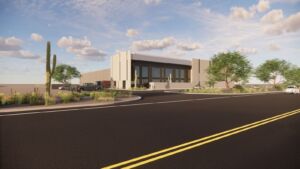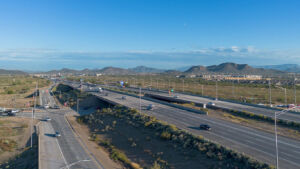The Metro Phoenix retail sector has seen a spectacular recovery since the pandemic, with Avison Young’s First Quarter 2024 Phoenix Retail Market Report stating that “since Q4 2020, Phoenix has rebounded, creating a national leading market with demand surpassing availability.” More than 1 million square feet of new space has been delivered in the last year, with an additional 2.7 million under construction, with the report calling the region “a bellwether for retail real estate in the U.S.”
MORE NEWS: Here are the retailers, restaurants coming to The Shops at Lake Pleasant
The last quarter of 2023 saw the Metro Phoenix retail direct vacancy rate at 4.9%, with Q1 2024 rising slightly to 5.2% thanks in part to the delivery of new construction. James DeCremer, principal at Avison Young, notes that vacancy is the lowest he has seen in his 21 years as a retail broker.
“It’s good because it means the retail sector and sales are healthy,” he continues. “The only problem is that we need to build more, and it’s challenging to build right now. Supply chain issues are normalizing, but all of the development and construction inputs including land costs, cost to improve the land and get it development ready.”
In Q1 2024, the Phoenix retail market saw its first negative net absorption since the pandemic at 397,567 square feet due to lease expirations and permanent closures of some larger retailers, such as 99 Cents Only closing nearly 40 stores in the Valley.
“What you had there in the first quarter is some new space being delivered and not all of it being absorbed. You also had some closures of box spaces,” explains Matt Milinovich, principal at Avison Young. “I don’t expect [negative absorption] to continue. I think we’ll be back on the positive side for the rest of the calendar year.”
Reuben Nach, commercial brokerage associate at R.O.I. Properties, adds that retail is still a fundamentally sound asset where pricing is less affected by the aftereffects of the pandemic.
“My clients and I are bullish on retail because of the limited inventory out there,” he continues. “There’s not a whole lot of construction going on, so that’s keeping the pricing of existing retail up — we’re still seeing high price per square foot and decently low cap rates.”
According to the Avison Young report, in Q1 2023, average rent stood at $22.52, indicating an increase of $2.25 or 8.8% when comparing year-over-year data. During the middle of the pandemic — Q1 2021 — rents were at $19.77, reflecting a substantial growth of 23.9% by Q1 2024.
From online to in-store
In the last few decades, the brick-and-mortar retail market has undergone a series of disruptions, from the advent of e-commerce to the drop-off in demand during the Great Financial Crisis. David Larcher, president and CEO of Vestar, says that throughout his 40 years in the business, one of the enjoyable aspects of retail development is the dynamic nature of the industry.
“You need to be at the forefront of those changes and anticipate them rather than respond to them,” he says. “We went through this period after the Great Financial Crisis when the world thought e-commerce was going to take over. Since COVID-19, brick-and-mortar retail has thrived and is proof that people do want to get out of the house.”
Large retailers, Larcher continues, are adapting to the demand for both brick-and-mortal locations and the convenience of online ordering by using physical stores as last-mile fulfillment centers. This allows people to buy online and pick up the item in the store, which also opens opportunities to make additional purchases once they are in the building, or to go to another nearby store.
“Most of the new stores in the shopping centers we’re building have specific facilities to accommodate that, which is definitely a trend,” Larcher says.
The International Council of Shopping Centers (ICSC) published a report examining the “halo effect” — or the impact that brick-and-mortar retail has on online sales. The report notes that opening a store boosts online sales in the trade area surrounding that area by an average of 6.9% in the immediate weeks following the opening.
“For emerging, direct-to-consumer brands, the benefits are even higher — the correlating halo effect for online sales is 13.9% when opening a new store. Conversely, closing stores has an even greater negative impact on retailer performance, resulting in an 11.5% drop in sales,” the report continues.
Headwinds for Metro Phoenix retail
Even though the retail sector has survived multiple shocks to the market over the past two decades, the current environment still poses challenges. Nach points to higher interest rates as a pain point.
“Interest rates hurt the institutional markets where all these deals are reliant on financing. But the segment in retail that’s doing better is deals under the $5 million threshold. That’s your single tenant net lease deals like Starbucks or [Raising] Cane’s,” he continues. “Interest rates are a headwind, but smaller deals aren’t getting hit too hard.”
Larcher adds that retail is in a unique place compared to the rest of his career since there’s an imbalance of supply and demand for space, with there being more demand for space than supply. The combination of interest rates and elevated construction costs, however, make meeting demand difficult.
“Those two factors will limit any new supply of retail space out there, so I don’t see a point anywhere in the near future where we’re going to reach an oversupply — and I’m not just talking here, but across the country,” Larcher concludes. “Over the last 15 years, even though the country has grown by about 80 million people, there’s been a declining supply of retail space as [nonviable properties] have been demolished. Assuming the consumer stays healthy, meaning we don’t hit recessionary or unemployment problems, we feel very good about what we’re seeing.”




